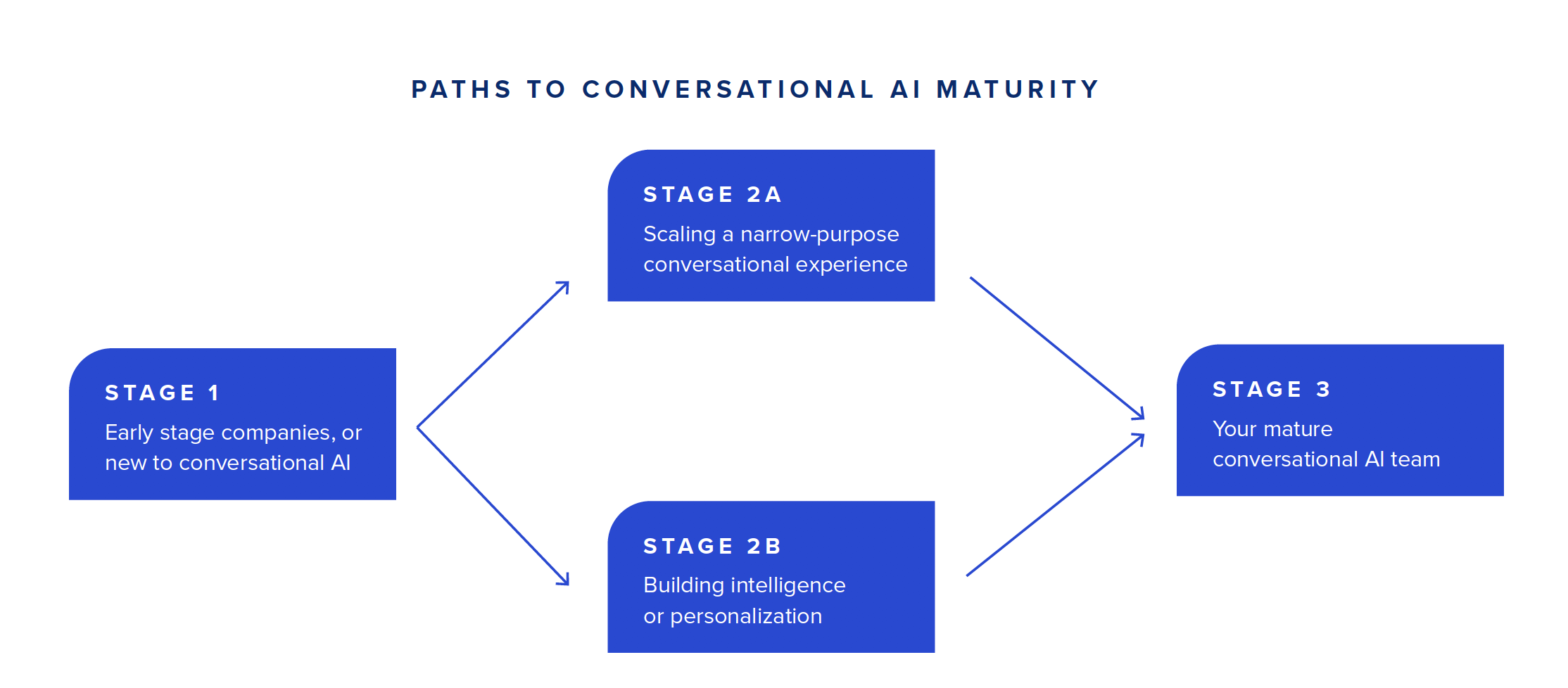
An Overview of Conversational AI
Conversational AI refers to the use of messaging apps, speech-based assistants and chatbots to automate communication and create personalized customer experiences at scale. On this page, you’ll find a deeper explanation of conversational AI as well as links to additional resources.
Understanding Conversational AI
A chatbot is a computer software program designed to simulate human conversation via text or audio messages.
Hundreds of millions of people use Facebook Messenger, Kik, WhatsApp and other messaging platforms to communicate with their friends and family every day. Millions more are experimenting with speech-based assistants like Amazon Alexa and Google Home. As a result, messaging and speech-based platforms are rapidly displacing traditional web and mobile apps to become the new medium for interactive conversations.
We refer to the use of messaging apps, speech-based assistants and chatbots to automate communication and create personalized customer experiences at scale as conversational AI. Conversational AI applications enable long-running interactions with customers via text or voice using the most intuitive interface available: natural language.
Conversational interactions are driven by words, whether in full sentences or in a menu. And, unlike social media, they can support engaging, two-way interactions with private audiences. When combined with automation and artificial intelligence (AI), these interactions can connect humans and machines through virtual assistants and chatbots.
Yet the real power of conversational AI lies in its ability to simultaneously carry out highly personalized interactions with large numbers of individual customers. Conversational AI can fundamentally transform an organization, providing more ways of communicating with customers, while facilitating stronger interactions and greater engagement.
Why Now?
Consumers are already using conversational AI platforms in place of email, phone calls and face-to-face communication to talk with family and friends. Younger people, in particular, tend to prefer messaging over other forms of communication. Not only that, social events are being organized via messaging apps, traditional texting is giving way to more functional and secure messaging applications, and early adopting consumers are using voice interfaces to make purchases.
Today’s consumers expect to be able to communicate with businesses on their favorite chat platforms, using text and voice, just as they currently do with friends and family. They want to do so because it’s easier, less intrusive and quicker than using other communication channels.

What Does It Mean for Your Business?
Conversational AI will change every aspect of when, where and how you engage and communicate with your customers. You need to be able to hold seamless, synchronous conversations with consumers across whatever channel they happen to be using at the time, no matter where they are. Importantly, those conversations could be a short one-off request or response, or part of a longer-running customer engagement.
As conversational AI becomes a business imperative, you need to be thinking about how to best prepare your organization for it.
What’s Fueling Conversational AI?
Conversational AI is based on the rise of messaging apps and voice assistant platforms, both of which are increasingly being fueled by artificial intelligence. And although these have traditionally been viewed as disconnected technologies, they are converging in increasingly important ways. Let’s take a closer look at each:
Messaging Apps
Over 2.5 billion people are using messaging services, with roughly a dozen major platforms claiming various geographic and demographic strongholds. Five of the 10 all-time apps are messaging apps, and 75 percent of smartphone users use at least one chat app.

Even Facebook, the king of traditional social media, has reinvented itself as a chat-first company. Today, there are more than 2 billion active monthly accounts across WhatsApp and Facebook Messenger, compared to 1.94 billion monthly active users on Facebook.
Meanwhile, 63 percent of Facebook users have increased messaging with businesses over the last year, with more than a billion messages exchanged between consumers and businesses each month on Messenger. And Instagram, with its 700 million monthly users, has also introduced a variety of new tools to encourage one-to-one chat between brands and consumers.
By the Numbers
- Mobile app usage is declining by 20 percent year over year.
- Most users spend 50 percent of their time using just one app, and that’s typically a messaging app.
- 75 percent of smartphone users use at least one messaging app.
- The number of messaging users have surpassed the number of social network users.
- Five of the top 10 apps of all time are messaging apps.
Voice Assistant Platforms
While the big selling point of messaging apps is immediate access to a pool of billions of users, the voice assistant market requires comparative patience. Amazon Echo, the far-and-away market leader, has only sold roughly 11 million units to date according to Morgan Stanley. And, eMarketer projects 35.6 million US consumers will use a voice-activated device at least once a month in 2017.

Although voice-activated assistants represent a nascent market, consumers’ enthusiasm is notably strong. Through a combination of word of mouth and extensive TV ad campaigns, Amazon Echo, and to a lesser extent Google Home, became mainstream hits during the 2016 holiday season. Studies show that consumers are particularly drawn to the technology’s speed compared to text, and its hands-free and eyes-free nature.
Early adopters of Echo gravitate most to activities like listening to music, news, and setting alarms and timers. But 45 percent of users report adding items to shopping lists on the device, and 32 percent have used it to purchase products on Amazon Prime.
Artificial Intelligence
The sophistication of your bot, and therefore your conversational AI capabilities, is largely determined by the sophistication of the artificial intelligence you employ on the backend. Tech companies like Microsoft, Google and Amazon are working hard to democratize advanced AI so that businesses can tap into their capabilities to introduce increasingly complex experiences.
Tech titans like Apple, Amazon, Baidu, Facebook, Google, IBM and Microsoft are engaged in an arms race. Each is allocating tremendous resources to drive AI progress, and to turn ideas that were once derided as fantasy into reality. Most are acquiring startups with specialized tech and expertise, committing tremendous capital to make technical breakthroughs, and at times rolling out those innovations to the public through consumer products and cloud services.
The Principles of Conversational AI
We have developed nine principles that you can use to help your company adopt conversational AI.
- Identify where you’ll have the greatest conversational impact.
- Understand your audience.
- Build complete experiences.
- Content enables conversations.
- Capture user context.
- Design for conversation.
- Personify your business.
- Bot or not?
- Keep private conversations private.
There’s a lot more on each of those principles here in our playbook for Conversational AI.
Those principles can be grouped in the following way:
Purpose
Begin by defining the purpose of conversational interactions in your business. Identify where conversational AI will make the biggest impact in your business. Ensure you understand the conversational platforms your users are already on. Document the application programming interfaces (APIs) and services your application will require to create a complete conversational experience.
Data
Conversational AI applications rely on data, both content and context, to engage users. Content is the information exchanged during natural dialogue with customers while context enables conversational applications to anticipate user needs.
Design
Recognize that creating conversational applications is different from traditional software development. Conversational design fundamentally is about language and human communication, personas that bring a brand to life, and incorporating the right level of automation.
Integrity
Finally, consider the integrity of the application with respect to user data. Set user expectations appropriately around what conversational information you are recording, how it will be used, and how you will protect that information.
The Importance of Chatbots
Chat apps have attracted billions of users, and bots are the mechanism that enable organizations to deliver highly personalized interactions at scale. Improved personalization delivers a more relevant user experience, and the high levels of automation used by bots enable cost-effective delivery at scale. As a result, businesses can engage with customers and achieve open rates that typically outperform email and social networks.
Yet studies indicate corporate adoption of chatbots currently lags behind consumer openness to the technology, and that businesses would be wise to pick up the pace. According to a survey by Retale, “59 percent of US Millennials and 60 percent of US Gen X-ers have used chatbots on a messaging app” and chatbots have higher long-term retention rates than traditional apps. Yet Forrester reports that as of late 2016, only 4 percent of businesses launched a bot.
The best bots in the market today accomplish seven key business goals:
1. One-to-one Conversation at Scale
Leveraging automation, businesses can carry on thousands or millions of simultaneous ongoing chats using the app’s native UX.
2. Personalization
With a rich trove of data, companies can tailor messaging at the individual level based on interests, past behavior and responses within the bot conversation.
3. High Engagement via Push Notifications
Once positive experiences have been delivered, businesses can leverage push messages that go directly into user inboxes. Marketers, in turn, can rely on high open rates and an effective ongoing mechanism for re-engagement.
4. A Cure for the Brand App Blues
ComScore reports that smartphone users spend 80 percent of their app time in only three apps. With multiple messengers topping app charts globally, having a piece of digital real estate on those platforms is an appealing alternative to building owned brand apps.
5. Revenue
AI-driven chatbots can lead consumers through the entire sales funnel from awareness to purchase.
6. Efficiency and Productivity
Bots have the capacity to enhance conversations between users by surfacing helpful information, or completing repeated tasks like scheduling.
7. Ambient Chat
Major brands from GE to BMW are integrating chat functionality into internet-connected devices, with bot technology powering those consumer interactions.
Building Your Conversational AI Team
People with these conversational skills are in high demand and short supply. Where do you begin? Is conversational AI even a profession yet?
With more business models and product avenues available, nuanced strategies are emerging for different conversational objectives. A company focused on growth will aim to acquire users quickly, whereas a company focused on engagement and LTV will need to deliver subtle, meaningful interactions with users before scaling. Each of these strategies will require a different set of skills and a different type of conversational product team.
1. Build a Conversational Roadmap
Create a conversational vision, strategy, and product roadmap will allow you to solidify your approach. You should consider whether you plan to buy, build, or take a hybrid approach.
2. Plan for the Right Skills Mix
You’ll need to acquire the right skills for your team while balancing budgets, source the best talent, and develop a culture and compensation strategy that will retain your team and keep them happy and productive.
3. Match Hires to Priorities
You don’t need a full team to get started. You’ll need product management, design and engineering for any project, but it’s possible to make headway using more generally trained resources that are willing to come up to speed on basic conversational AI best practices. That said, adding experienced conversational AI specialists when you’re able to will help maximize your chances of success.

4. Acquire A-Players
Competition for talent in these areas is fierce, so you may need to get creative. While you might find hires from academia, consider looking to post-graduate certificate programs or other alternative paths as well. Post a challenge to Kaggle, or attend conferences as a way to engage with the community.
Grab your copy of our guide to building conversational AI teams
- Role descriptions, reporting structure, and sample job descriptions
- Advice on where to source the best talent
- Interview questions
- Tips on how to onboard your conversational team
- Steps to create a culture to attract top conversational AI talent
Read more like this
KumoVC: Turning Venture Data into Instant Predictions with KumoRFM
Originally published on Kumo.ai’s blog. In this technical blog post, Azin and…
Verticalized Voice AI – The Next Application Layer Shift
Every decade or so, a new interface reshapes not just how people…
From Static to Adaptive: Scaling AI Reasoning Without the Waste
2025 has been the year of reasoning models. OpenAI released o1 and...